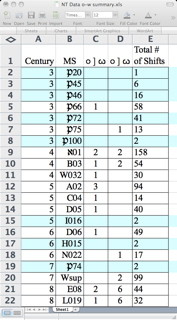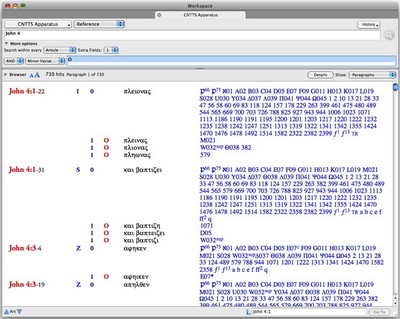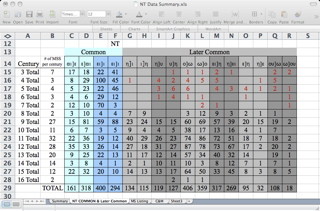Somewhat lost among all the new product announcements at the annual meetings of ETS and SBL was the news that the CNTTS Apparatus is now complete. We’ve been working with the Center for New Testament Textual Studies at New Orleans Baptist Theological Seminary for years now to release their New Testament Critical Apparatus for use in Accordance. The apparatus has been released in stages, with new portions of the New Testament appearing each year. With this year’s release, the apparatus now covers the entire New Testament.
While at SBL, we asked Steven Whatley, Research Associate at the Center for New Testament Textual Studies, to write a guest blog giving an inside look into this remarkable tool. This he graciously agreed to do. We hope you enjoy this inside look into the kind of research the CNTTS Apparatus makes possible.
When I was preparing to begin my postgraduate studies in New Testament, I told my wife that I was buying a laptop and that the laptop was going to be a Mac and that Accordance Bible Software was going to be my first software purchase. There have been absolutely no regrets. Accordance Bible Software has consistently met my needs as one of my research tools in New Testament (NT) studies.
My primary field of study is New Testament Textual Criticism. Early on in my academic career I was taught that as the Greek language developed, certain vowels and consonants began to be pronounced the same. This resulted in scribal confusion between such letters and this phenomena is called itacism. Since this was a developmental process, I asked the question, “When did certain itacisms begins to occur and did they develop all at the same time?” At that time the Center for New Testament Textual Studies New Testament Critical Apparatus (CNTTS NTCA) was in its beginning stages and I had the privilege of being one of many who were developing this new research tool. Because the CNTTS NTCA was, and is, a digital searchable database of NT variants it has the capacity to include all variant readings from a manuscript, not merely a select few. Therefore I was able to isolate individual orthographic shifts (spelling changes) and determine that not all orthographic variant readings are the same. The task of gathering sufficient evidence for a study of orthographic shifts was totally impractical to do by means of manual collations only. It is only because of the ability to search for specific types of variants in the digital database that this study is even possible.
My study in the area of orthographic developmental patterns among scribes of the NT has continued for the past few years. My research thus far was recently presented at the Annual Meeting of the Society of Biblical Literature in New Orleans, LA. I demonstrated that I was able to search for and isolate orthographic shifts in specific chapters of the NTCA. Here is a screen shot from an initial search in which the perimeters of the search are set to find all orthographic shifts (minor variations code “O”) in John 4.
Several more chapters were searched and the resulting data were copied into Excel. I was able to produce charts and tables of the data. The totals gathered thus far indicate that not all orthographic shifts were created equal or at the same time. The chart shown here includes the total number of common and later common itacisms identified in the NT chapters researched thus far in the study (data for uncommon shifts are recorded but not included here).

This is only a sampling of the data gathered thus far. Naturally, there is more evidence than can be presented in this blog entry and now that the entire NT is represented in the CNTTS NTCA I look forward to seeing what the evidence will reveal concerning the orthographic scribal habits found in many of the NT manuscripts.
Thank you to everyone who works at Accordance Bible Software and the CNTTS for making this invaluable tool available for NT researchers. Now, perhaps, someone can find evidence of scribal habits in other areas such as nomina sacra or transpositions, just to name a couple.
Steven K. Whatley,
Research Associate at the Center for New Testament Textual Studies,
New Orleans Baptist Theological Seminary



